Буква я картинка для детей: Картинки про букву Я детям — учим русский алфавит
Буква Я — Заюшка

якорь
Слоги с буквой Я
мя пя тя ся ня ля бя вя ря фя дя зя
Слова на букву Я с картинками
 я-бло-ко
я-бло-ко
 я-бло-ня
я-бло-ня
 я-чмень
я-чмень
 яй-ца
яй-ца

 я-хта
я-хта
 я-ще-ри-ца
я-ще-ри-ца
Стихи с буквой Я
Буквы Я и Ю поют.
Пела песню буква Ю,
Пела песенку свою —
— Ю-ю-ю, ю-ю-ю,
Я пою, пою, пою!
Подошла к ней буква Я.
— Что за песенка твоя?
Нужно только петь, как я —
Я—я—я, я—я—я!
Ярко солнце засветило.
Ярко солнце засветило,
Яхта якорь опустила.
Проплывает в речке язь,
Он плывет не торопясь.
А на камне у реки,
Где песок и волны,
Ящерица греется,
Солнышком довольная.
***
Ямки выкопали в парке.
Там посадят кустик яркий,
А еще прекрасный
И высокий ясень.
Слова и слоги с буквой Я
Чистоговорки с буквой Я
Задания с буквой Я
Другие буквы с картинками и Азбука от Заюшки с картинками, детскими стихами и заданиями.
Материал предназначен для родителей и воспитателей, для использования дома и в детском саду.
Копирование для распространения в интернете запрещено.
Буква Я формата А4
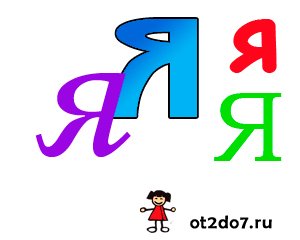
Ярко-ярко солнце светит.
Яхта фрукты возит детям.
Привезла нам с ярмарки
Ягоды и яблоки.
В данной подборке 15 шаблонов буквы Я для раскрашивания, вырезания, любого детского творчества.
Выбирайте любую понравившуюся букву, щелчком правой кнопки мыши вызывайте меню, скачивайте или распечатывайте.
В конце есть ссылка на полный архив шаблонов. В шаблоне буквы не помечены знаком сайта.
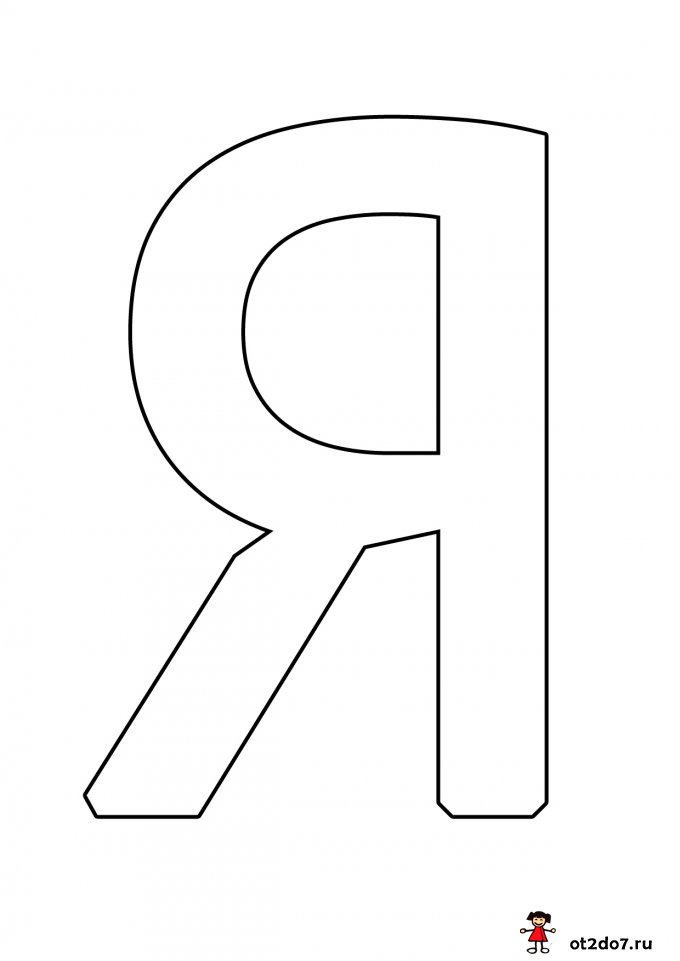 Буква Я формата А4
Буква Я формата А4
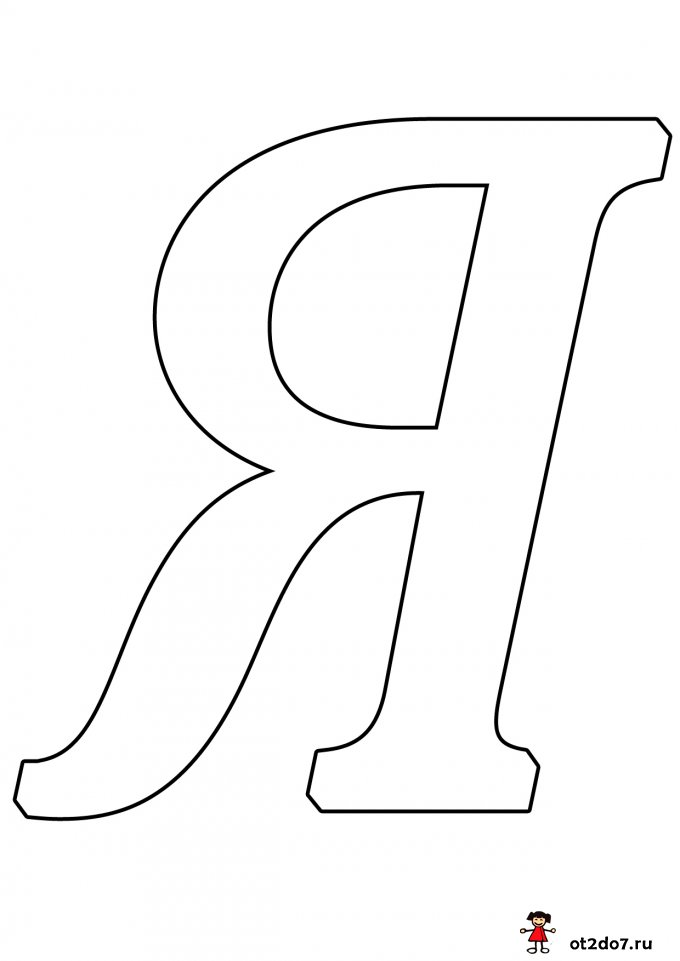 Буква Я формата А4
Буква Я формата А4
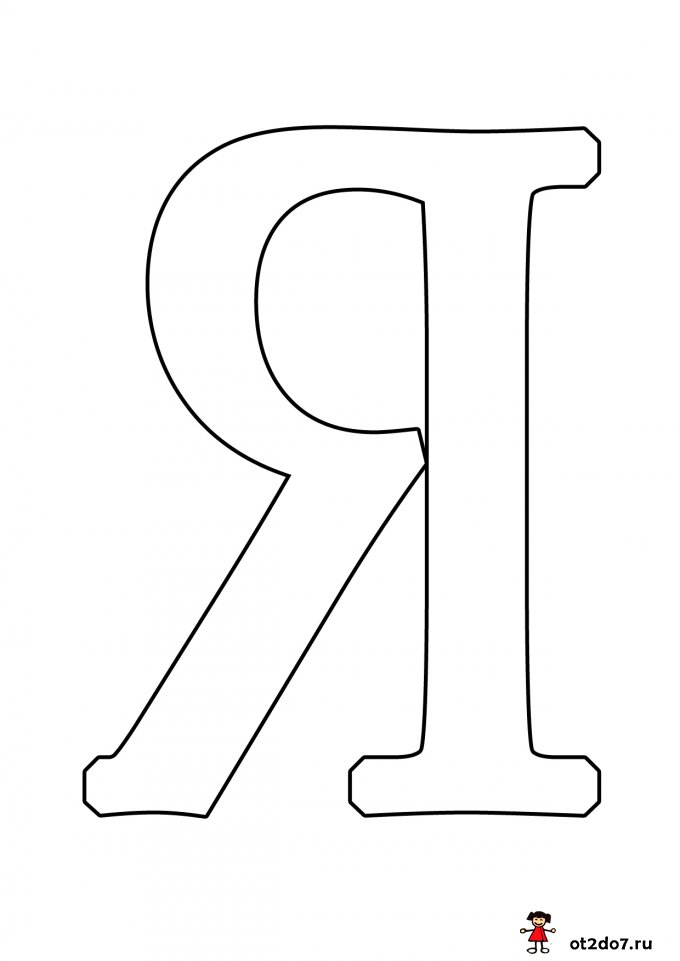 Буква Я формата А4
Буква Я формата А4
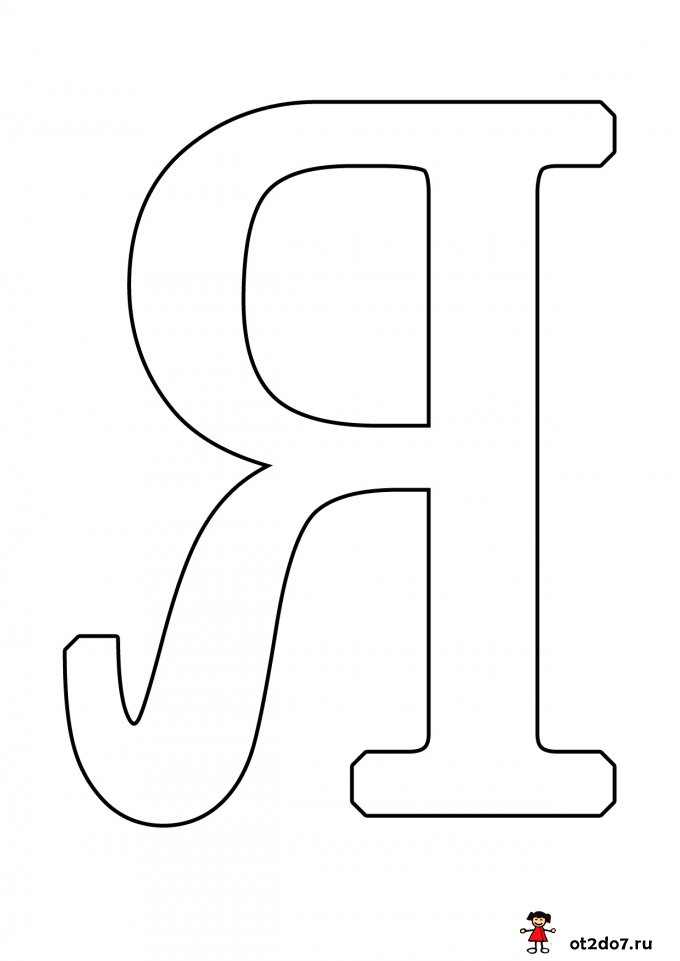 Буква Я формата А4
Буква Я формата А4
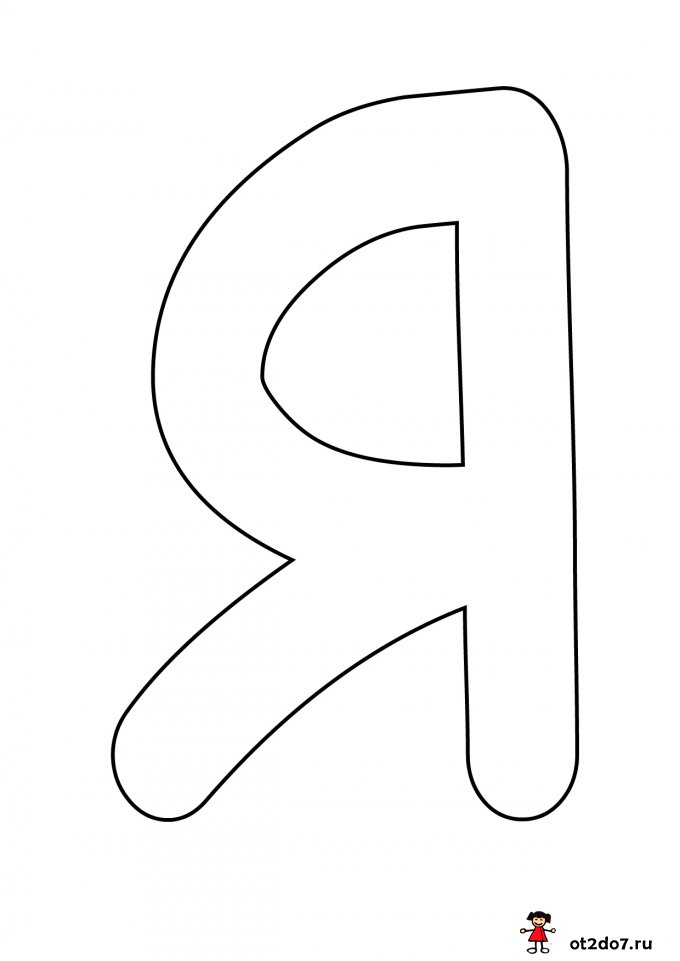 Буква Я формата А4
Буква Я формата А4
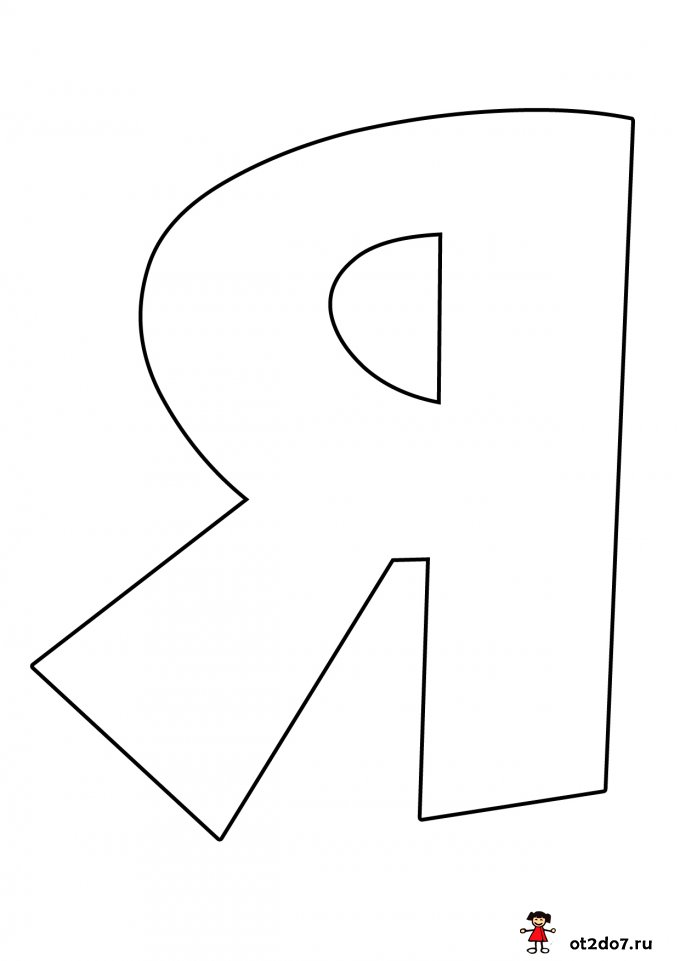 Буква Я формата А4
Буква Я формата А4
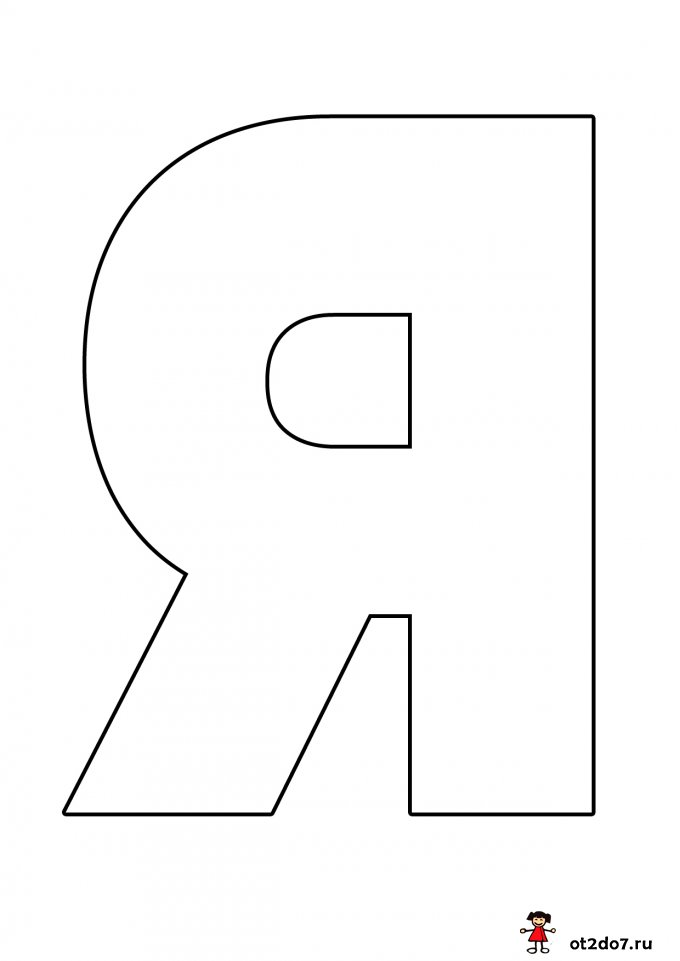
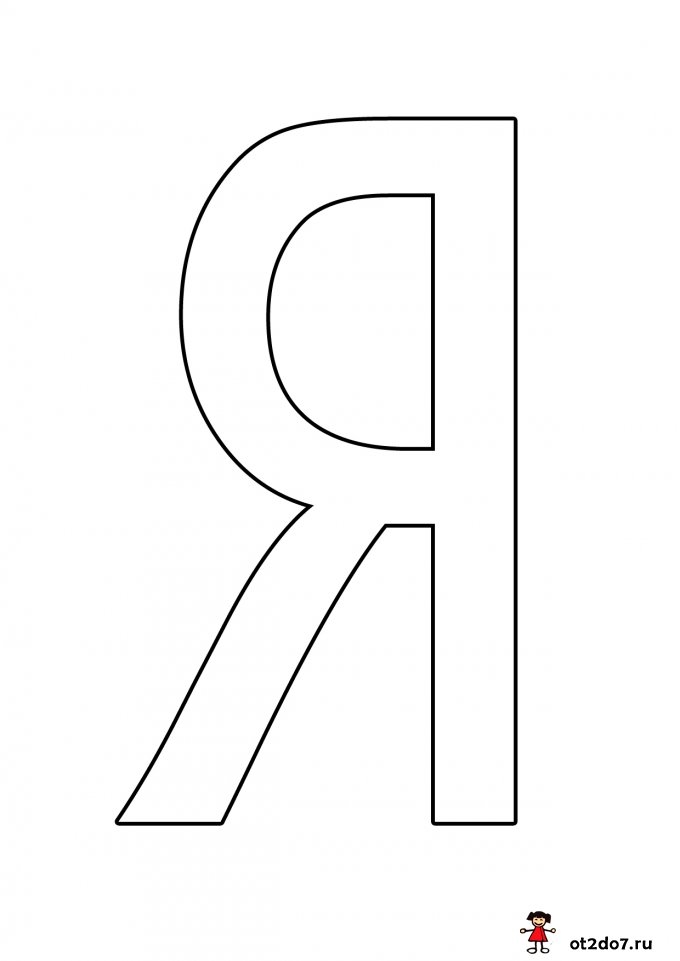 Буква Я формата А4
Буква Я формата А4
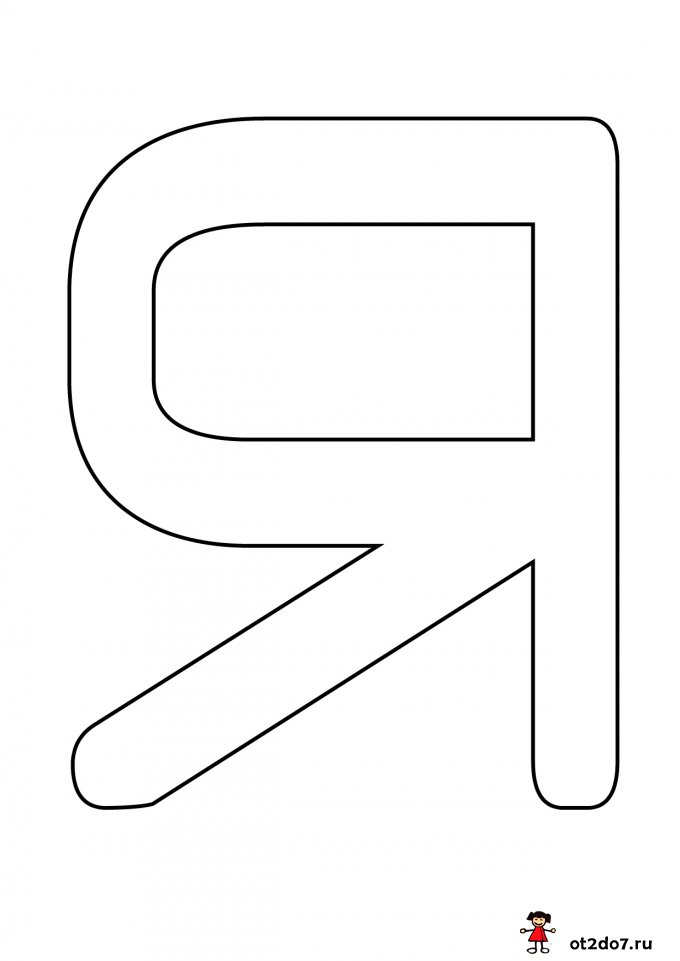 Буква Я формата А4
Буква Я формата А4
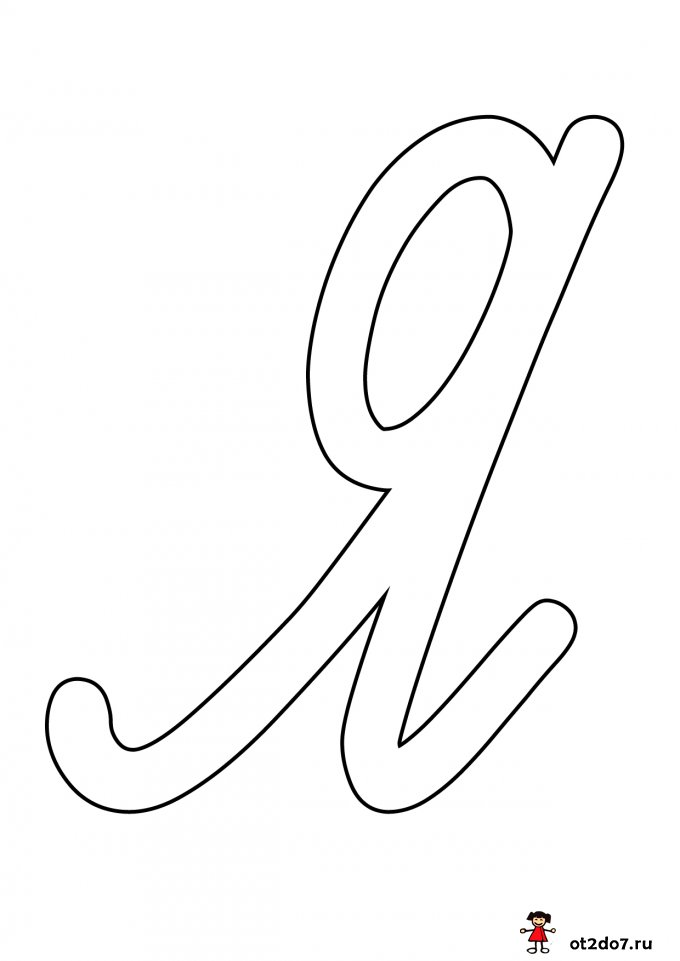 Буква Я формата А4
Буква Я формата А4
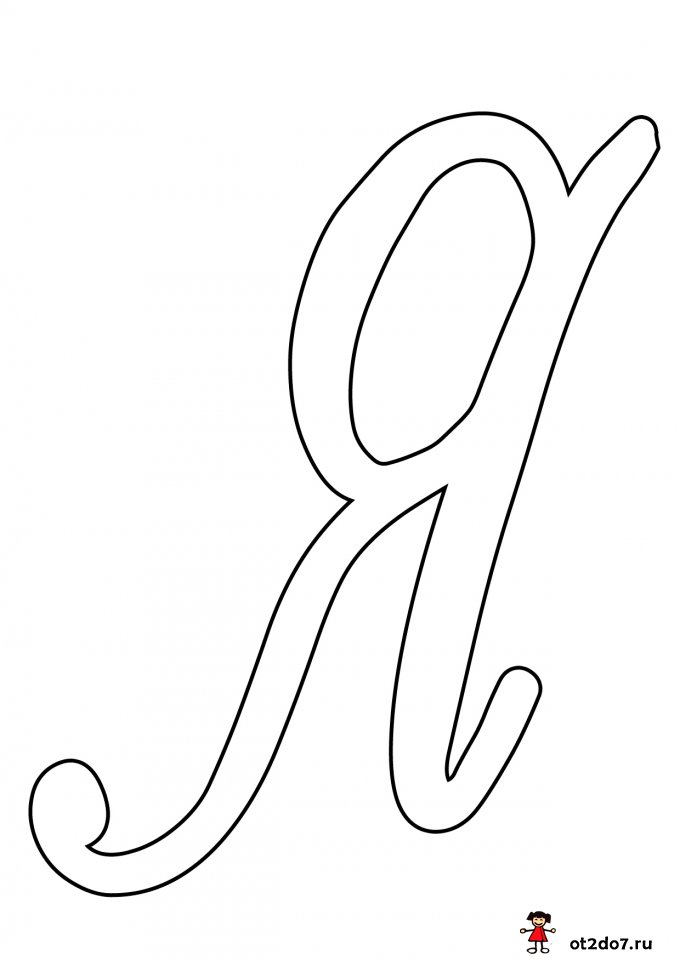 Буква Я формата А4
Буква Я формата А4
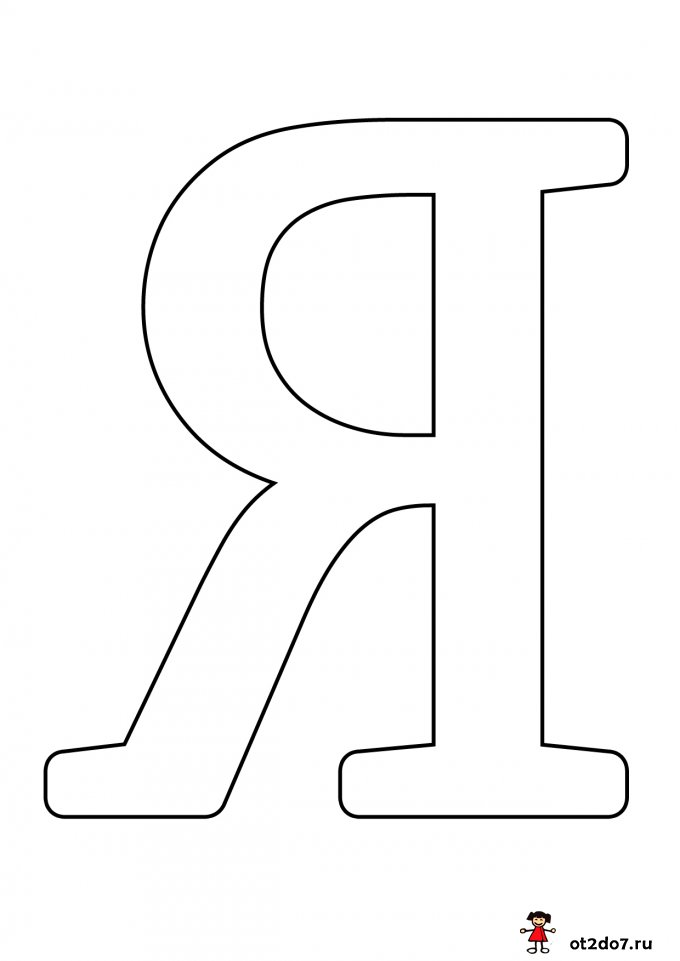 Буква Я формата А4
Буква Я формата А4
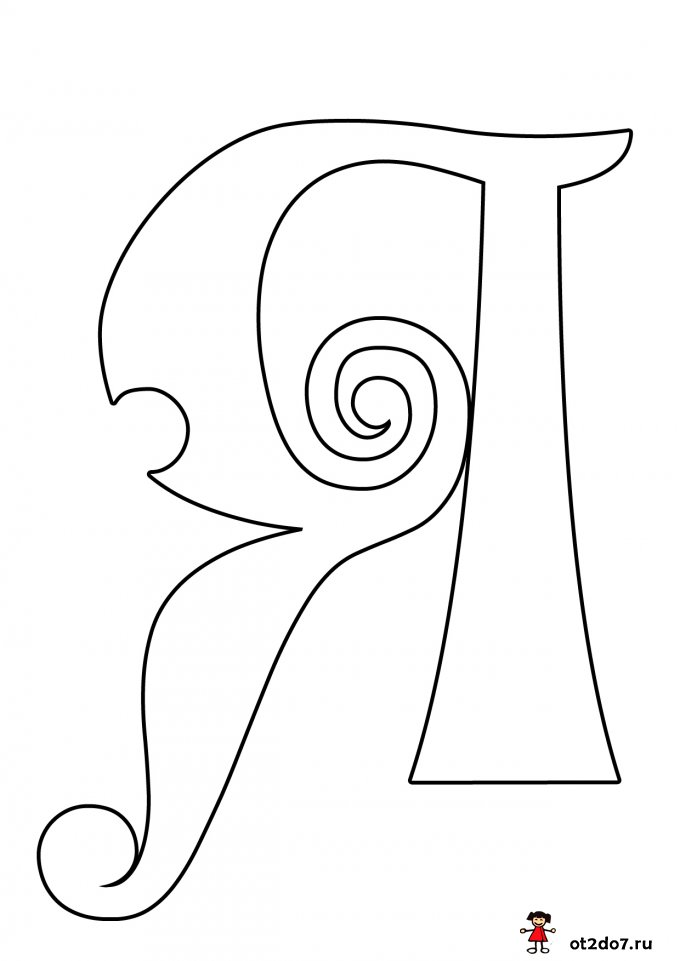
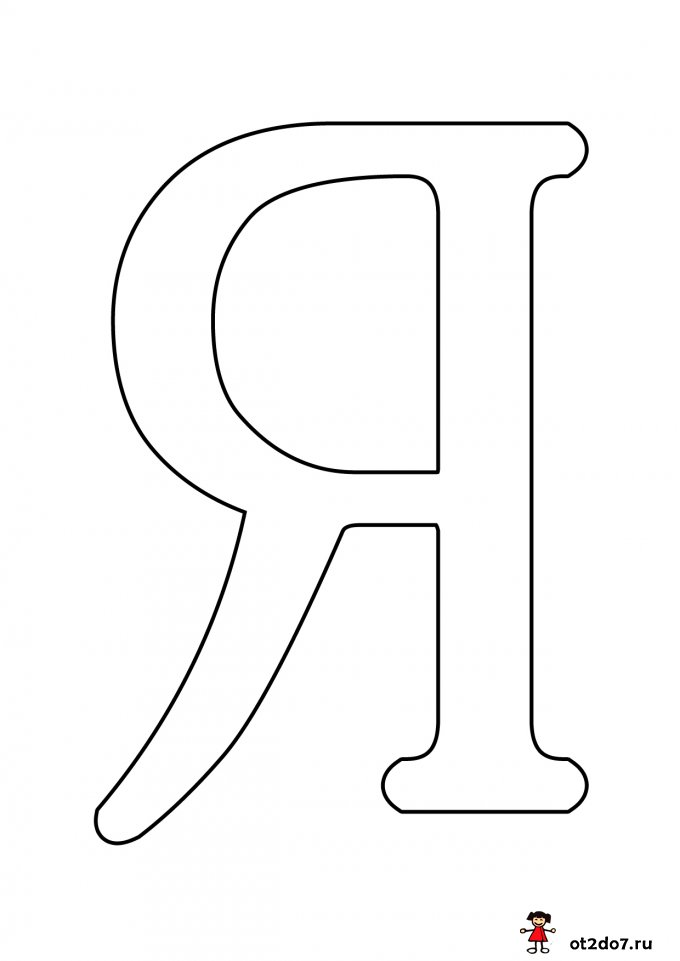 Буква Я формата А4
Буква Я формата А4
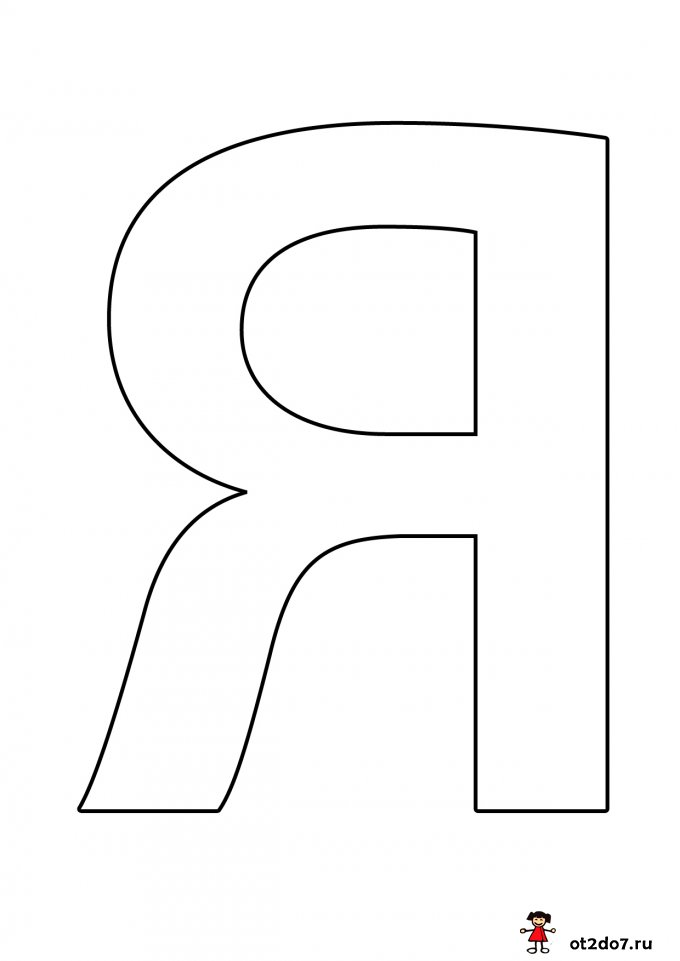 Буква Я формата А4
Буква Я формата А4
Скачать файл: a4.zip [1,18 Mb] (cкачиваний: 24)
Уважаемые читатели!
Все материалы с сайта можно скачивать абсолютно бесплатно. Все файлы проверены антивирусом и не содержат скрытых скриптов.
Картинки в архивах не помечены водяными знаками.
Если материал нарушает чьи-то авторские права, просьба написать нам по адресу [email protected], указав авторство материала. Мы обязуемся (по вашему желанию) либо убрать материал, либо указать прямую ссылку на автора.
Сайт пополняется материалами на основе бесплатной работы авторов. Eсли вы хотите отблагодарить их за работу и поддержать наш проект, вы можете перевести любую, не обременительную для вас сумму, на счет сайта.
Заранее Вам спасибо!!!
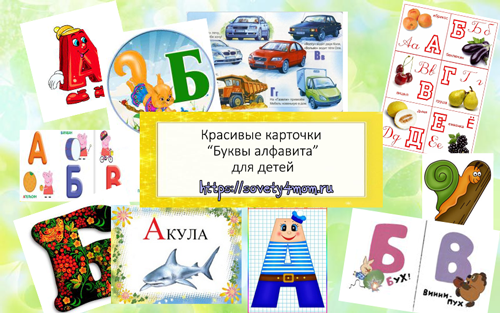 Учим буквы
Учим буквы
На чтение 2 мин. Просмотров 145 Опубликовано
В данной статье я собрала красивые картинки буквы алфавита для детей, шаблоны которых можно скачать совершенно бесплатно, распечатать и играть. Вариации игр с такими буквами см. в разделе «Учим буквы»
Чтобы скачать понравившиеся карточки, нажмите на подзаголовок и система автоматически откроет страницу на яндекс диск
Слова на букву А для детей
Слова на букву А для детей в начале слова картинки. Вы хотите, чтобы Вашему ребенку легко давалось обучение в школе и Вам не приходилось постоянно контролировать его? Тогда необходимо сделать так, чтобы он изучил все буквы до того, как пойдет в школу. Чтобы они закрепились у него на уровне автоматизмов, нужно правильно начать знакомство с ними и дальнейшее изучение, запоминание букв будет легким и приятным, как игра.
Содержание статьи:
Как легко выучить букву А ребенку в 3-4 года и в 5-6 лет?
Ребенок обладает впитывающим разумом. Это подтверждает Мария Монтессори, посвятившая свою жизнь воспитанию детей. Период особой восприимчивости человека к изучению букв от 0 до 6 лет. Однако, ребенок должен быть готов к изучению и настроен на него. Есть дети, которые как только начинают говорить уже интересуются буквами, конечно же, если родители им предложили их изучать и создали позитивное подкрепление этому событию, то есть бурно порадовались, когда ребенок первый раз начал проявлять интерес к буквам.
Есть мнение, что изначально ребенок должен освоить физическую подготовку, научиться ловко управлять своим телом, то есть освоить лазание, ползание, ходьбу по ступеням — развить крупную моторику, а также развивать мелкую моторику — движения кончиками пальчиков: лепку, рисование, перебирание мелких предметов. И лишь потом можно обучать буквам. То есть годам к 5-6 как раз будет нормально.
Я на своем личном опыте считаю, что все нужно делать одновременно и параллельно, следуя за желанием и интересом ребенка. То есть начинать изучать буквы и показывать их можно еще когда ребенку не исполнилось и года. В 3-4 года ребенок в норме должен уже иметь довольно большой словарный запас и поддерживать беседу. Возможно именно этот период окажется подходящим для начала знакомства с буквами?
Изучаем букву А играя — На что похожа буква А?

Важно пробудить в ребенке интерес и поддерживать на пути познания. Начните заниматься изучением букв как можно раньше в простой игровой форме. Когда гуляете с ребенком, общаетесь, играете с ним, обращайте его внимание на буквы. Они окружают нас повсюду. Обращайте внимание на что похожа буква А. На лесенку-стремянку, на два бревна и еще одно между ними. Может быть какое-то дерево растет в форме буквы или что-то еще? Эйфелева башня?
Важно, чтобы у ребенка возникли положительные эмоции в момент изучения букв. Он может радоваться, что мама или папа рассказывают ему нечто важное. Расскажите ему как помогают буквы людям. Что можно самому читать, определять на какой улице ты находишься, найти какой мультик посмотреть самому.
У каждого человека есть несколько каналов восприятия информации: аудиальный (на слух), визуальный (картинка), кинестетический (на ощупь) и двигательный (схема, алгоритм). Какой канал восприятия развит сильнее у каждого конкретного человека помогут определить специальные тесты. Заложено это генетически или формируется в зависимости от среды, окружающей ребенка пока не понятно. Я согласна с мнением, что ребенку можно помочь развить все каналы восприятия, поэтому очень важно, чтобы он:
— услышал букву;
— увидел образ — картинку;
— потрогал его в реальном мире;
— нарисовал его.
Почему буква А с картинками перед словом лучше запоминается?

Для ребенка буквы это абстракция, что-то непонятное. Важно, чтобы помимо самой буквы он запомнил еще и образ — картинку. Все мы помним свою первую азбуку, там около каждой буквы была картинка. Еще лучше, если у ребенка будет пример из реальной жизни. Например, на нашей карточке есть слово Абажур. Найдите его в своем доме и дайте рассмотреть ребенку. Буквально потрогать и проверить “на зуб” можно что-то съедобное на букву А, например, арбуз, абрикос, ананас, апельсин. Астру можно понюхать. Автомобили и автобусы окружают повсюду городских жителей, а ездят они по асфальту. Нарисуйте мелом букву А на асфальте на прогулке.
В кино снимаются актёры и актрисы, в цирке акробаты и арена. Возможно у вас в доме есть аквариум? Найдите именно практическое применение абстрактной букве. Посадите рисовать ребенка акварельными красками и зафиксируйте внимание, что акварель начинается на А. Пусть он нарисует акварелью А с вашей помощью или самостоятельно, если сможет. Такой опыт проникнет в самую глубину сознания ребенка и его мозг впитает эту важную информацию о первой букве русского алфавита, который тоже начинается на А.
Любит ли ваш ребенок рассматривать животных: подойдут слова аист и акула. На современных домах на улице полно антенн, обратите внимание ребенка на них и он автоматически будет вспоминать букву А, когда будет видеть антенну. Также вокруг много надписей, содержащих букву А, например, АптекА. А может ваш ребенок любит слушать музыку? Тогда обратите его внимание на музыкальные инструменты на А, например, Арфа, Альт. А какие способы легкого запоминания информации используете вы сами?
Слова на букву А для детей а начале слова — 23 картинки
Если картинка яркая, она привлечет внимание ребенка больше и останется в его памяти навсегда. Посмотрите на нашу подборку картинок ниже.
В журнале вы найдете слова на букву А: Абажур, Абрикос, Автобус, Автомобиль, Аист, Акварель, Аквариум, Акробаты, Актер, Актриса, Акула, Алфавит, Альбом, Ананас, Ангел, Антенна, Апельсин, Аптека, Арбуз, Арена, Арфа, Астра, Асфальт.
Листайте журнал и изучайте слова на букву А.
Картинки для раскрашивания на букву А
Еще лучше запомнить буквы поможет творческая работа с ними. Если ребенок сам сможет раскрасить буквы, он лучше их запомнит. Распечатайте готовые трафареты и раскрашивайте букву А вместе с ребенком!





Мультик про букву А
Можно также показать видео с картинками своему малышу, если вам совсем некогда читать ему самостоятельно, но помните, что живое общение наиболее эффективно и предпочтительно в общении с малышом. Когда вы рассказываете что-то лично, укрепляется родительский авторитет и ваши отношения с ребенком, что является несомненным вкладом в будущее. А видео можно посмотреть и совместно!
Мультик про буквы А, Б, В, Г, Д, Е, Ё, Ж, З, И от Теремок ТВ
Стихи про букву А
Стихи и рифмы удерживаются в нашей памяти на дольше и запоминаются быстрее. Почитайте стихи с ребенком во время изучения буквы А и вы убедитесь, что они помогают лучше запоминать буквы.
Вот два столба наискосок,
А между ними — поясок.
Ты эту букву знаешь? А?
Перед тобою буква А.
С. Маршак
***
А — начало алфавита,
Тем она и знаменита.
А узнать ее легко:
Ноги ставит широко.
А. Шибаев
ВНИМАНИЕ! КОНКУРС ОТЗЫВОВ!
Скачайте любую нашу мини-книгу БЕСПЛАТНО, напишите отзыв и выиграйте призы!
Подробнее на странице конкурса: https://multi-mama.ru/konkurs-otzyvov-izuchaem-vmeste-s-rebenkom/
Все стихи на букву А для детей дошкольников
Вам понравилась наша подборка: слова на букву А для детей в начале слова картинки? Напишите какие еще слова на букву А вы знаете!
90000 Learning English through picture books | LearnEnglish Kids 90001 90002 90003 By Opal Dunn, author and educational consultant 90004 90005 90006 Picture books 90007 90002 Every year thousands of children’s picture books are published in the UK. Children’s corners in bookshops offer a bewildering choice of new and old favourites, illustrated by some of the best artists working in Britain today. Native-speaker children have many opportunities to enjoy these picture books; there is no reason why young children learning English as an additional language should not enjoy them, too.90005 90006 The advantages of beginning early 90007 90002 From the very first introduction to listening to English, children can enjoy carefully selected picture books. Young learners soon pick up the short text of a picture book, if initially it is shared with an adult who brings the pages alive. 90005 90002 Children are already familiar with stories. From a very young age they talk in narrative style. It is through their stories of everyday experiences that they define themselves: expressing their ideas, hopes and emotions in language as well as in drawing and imaginative play.90005 90002 Many children are already used to decoding stories and information from television or film in their home language, while others may have already enjoyed the interaction of sharing a picture book. Most children, if guided by a parent, soon work out how to transfer their individual decoding skills to get meaning from picture books in English. 90005 90002 Sharing picture books is not only about picking up another language, it is also about giving children a wider window on the world, guided by their parents.The one-to-one interaction of sharing picture books gives children added opportunities to develop holistically at their own speed and level, knowing that their parents are encouraging them. As children share more and more books their self-confidence develops. This can often be seen in the way they approach unfamiliar English and new experiences. 90005 90002 Picture books provide parents and children with an obvious reason for switching from their home language to speaking English. Parents who lack confidence in English find that the fixed text of a picture book is a useful prop.Apart from providing text to read and share, a picture book can be the basis for interaction, which parents can adjust to their child’s developing needs, interests and attainments. 90005 90002 Some parents may be concerned that introducing picture books will not fit in with their child’s school syllabus or text book. Sharing a picture book is an additional English learning experience that bonds families and helps children realise that speaking English at home is fun. Many families enjoy slipping English phrases picked up from picture books into everyday home language conversations.’Not now, Bernard’ is quite a favourite! 90005 90006 Learning from picture books 90007 90002 It takes time to build up a child’s readiness to talk about picture books in English. Children’s silence, however, does not mean that they are not listening and learning. Children usually understand more than they can say in words and, if the book experience is focused and fun, they usually want to pick up the new English at their own speed. Children are busy exploring their world and most are keen to find out something new, particularly if it is presented in an encouraging and attractive way.90005 90002 Parents can underestimate their children’s ability to pick up more text each time a picture book is shared. Many are surprised to see how keen their children are to join in ‘reading’ if they are encouraged to finish off a sentence or say a stressed word like ‘No’ each time it occurs. Once children work out how to join in, they gradually extend their skills to pick up whole short sentences until, eventually, they can recite most of a text as they turn the pages to match it to the illustrations.Many a busy parent purposely skipping a little text has had their ‘mistake’ pointed out by their child! 90005 90002 Young children’s boredom threshold differs from adults ‘. Many may ask for the same book to be read and re-read. Parents need to respond positively to these requests as re-readings provide the natural repetition children may need for making meaning or picking up new language as well as confirming and refining language they have already acquired. 90005 90002 Picture books, sometimes referred to as ‘real books’, to distinguish them from graded text books, expose children to a range of language structures and vocabulary familiar to native-speaker children.90005 90002 Illustrations in real picture books are not merely supporting understanding of language, as might be the case in many text books. The different styles of artwork naturally broaden children’s visual experiences. One of the delights of sharing picture books with children is that, on first viewing, children tend to look at an illustration as a whole but with repeated reading of the book, details and subtleties usually emerge. 90005 90002 The illustrations may be by well-known artists, pictures may be photographs or the books may contain 3D novelty paper sculptures.How exciting it is for children to hold art in their hands. There is no doubt that exposure to picture books increases visual decoding skills and over time influences creativity and the ability to appreciate design and illustration. 90005 90002 Picture books also help children find meaning within their own life. Children can pore over emotional situations contained within picture books that may help to relieve personal frustrations, or they can encounter exciting and imaginative experiences way beyond their own environment or even their dreams.Imagine the power a child feels as he or she firmly shuts a book and says, ‘GOODBYE Giant!’ 90005 90006 Selecting picture books 90007 90002 Picture books may be: 90005 90044 90045 story books — short simple story text including conversation and rhyme 90046 90045 information books, with short explanatory text 90046 90045 rhyme books, which might introduce one story rhyme or an anthology of poems 90046 90045 novelty books, with short text and 3D paper sculpture 90046 90045 character series books, with an accompanying character doll or puppet.90046 90055 90002 Parents need to select books that they enjoy and feel they can read confidently — enthusiasm is infectious! Before they introduce a book, they need to plan how they are going to read the text and, each time they re-read, follow the same plan. Children find it more difficult to pick up language if the reading differs each time. 90005 90002 In the early stages it is vital to select books with short texts, if children are to pick up language successfully and in a way that self-motivates.Children can measure their own success and this, together with merited adult praise, contributes to a positive feeling about sharing English picture books. 90005 90002 Where a simple text is slightly longer, it is generally advisable to limit the first reading to the essential story language. Once this is understood, the descriptions can be gradually added using parentese language. 90005 90002 Most books should be selected to include some language a little beyond a child’s level in English, so the child can start from familiar language and move on to some new language.90005 90002 Once children have shared several books successfully, the habit of ‘reading’ together regularly in the family in English is likely to be established. 90005 90002 Ideally a book should include some words or phrases that can be transferred to children’s everyday English, so giving them opportunities to use their innate skills to transfer language to different situations. 90005 90002 In selecting books parents need to think about gender and include some books that appeal to both boys and girls, so children have some common story experiences to exchange.Some boys find it easier to relate to information books rather than story books. 90005 90006 CD-ROMs and DVDs 90007 90002 Some story books are sold with an attached CD-ROM or DVD. These offer children a different, less intimate and more passive experience than sharing picture books. For profound learning, it is best to share the book until children know most of the text by heart before exposing them to either the CD-ROM or DVD. 90005 90002 Apart from the wealth of all-round experiences that come from sharing, children may not be ready, before they are familiar with the text, to cope with a voice and even accent that is different from their parents ‘.90005 90002 By this time children are likely to have found out how to enjoy the picture book, and may even want to read by themselves. 90005 90006 Book time 90007 90002 For successful sharing it is important to set the scene for regular book times. Children need to know that this is when they can snuggle up to parents and feel confident that their parents will focus only on them and sharing the book. 90005 90002 Book time may be a single session or part of a larger English session which includes other activities in English.Ideally there needs to be an ‘English book time’ every day or at least every weekday at about the same time, as frequent short exposure is more effective than fewer, longer sessions. Length can vary from ten minutes to longer periods to match children’s readiness to learn and mood on the actual day. Regularity gives a feeling of security and something to which children can look forward. 90005 90002 It is a good idea to share the choice of books to be read, as children’s requests may hide emotional or language needs.A new book is best introduced once children are beginning to ‘read’ the other books successfully. Presentation of a new book should be saved for a day when both parents and children ‘feel good’. 90005 90006 Parents ‘role in introducing new books 90007 90002 In the initial stages children are dependent on the parent’s reading and interaction for input and picking up language. The role gradually changes as children begin to share a little of the reading. As children’s reading ability increases, the role of the parent gradually diminishes.90005 90002 By the time children know the text by heart and are capable of ‘reading’ the book aloud to themselves or to others, the parent’s role is reduced to re-phrasing mistakes and praising successes. 90005 90002 Throughout this time the parent is managing the experiences and tuning into their child to find out what stage they have reached and where they need added support. This cycle repeats each time a new book is introduced, but as children learn more English the cycle takes less time.90005 90006 Book browsing 90007 90002 Book browsing is a form of play where children enjoy books by themselves, in their own time, turning the pages when they want. Like all self-initiated play, it is an important part of learning, as it gives children time to revisit what they want and consolidate their learning at their own level and speed and not that of the parent. 90005 90002 Young children also need opportunities to ‘read’ to the extended family, as it is natural for them to want to demonstrate their achievements; it is also a form of play.Successes motivate and help to confirm in children’s minds that reading a book in English is what the family expects and finds fun. Young children want to please their parents and also share fun times with them. 90005 90006 Building up a home library 90007 90002 Books that children already know well need to be stored in an available place so that, when they feel like it, they can take a book and ‘read’ it aloud to themselves. At this stage most children are not capable of silent reading. 90005 90002 Ideally books should be stored with the front cover facing outwards — looking at a book’s spine is less likely to motivate browsing at this age.90005 90002 Books should not be added to the home library before children know quite a lot of the text language. If children find they can not read a text of a book in the home library, they are most likely to be demotivated. Keeping the feeling ‘I can’ is important in the initial stages. Any ‘I can not’ feelings take time and encouragement to change. 90005 90006 Sharing reading 90007 90002 The amount of parentese language parents need to use depends on children’s language level in both their home language and English.90005 90002 In the first few sharings of a new book, parents need to remember the following: 90005 90044 90045 Make sure that children are close enough to see how the parent’s lips move to make sounds and how the eyes and face, as well as body language, convey the excitement and emotions which facilitate understanding. 90046 90045 Read at the children’s pace, letting them look at the picture for as long as they need. Young children are used to getting visual information to facilitate understanding.They often indicate that they have finished looking by turning their faces to look at the parent. 90046 90045 Dramatise the story reading and if possible include some physical gesture, as physical involvement helps in memorising language. 90046 90045 Use different fun voices for animal noises and characters like ‘a cross Grandma’, as you read the story. Children love to imitate characterisation and transfer it to their own ‘reading’ aloud. 90046 90045 Point to each word as you read so that children develop better left-to-right eye movement, and become conscious of the shape of words.90046 90045 Encourage joining in by letting children finish off sentences or make the noises of animals or transport. 90046 90045 Once the reading is finished, close the book and stay silent for a few seconds. Children may be in their own imaginative world and need time before they are ready to leave it. 90046 90045 Asking too many questions about the book can spoil the magic. Families who enjoy books together often find that children, when they are ready, talk to them about the shared English books in their home language.90046 90045 If children use a home language word or phrase while talking English, it is generally because they have not yet acquired the word in English or have forgotten it. Make no mention about the mixture of language and repeat back to them the whole phrase in English. They will notice and generally pick up the English, ready to use it at some later stage. 90046 90055 90006 How does the child understand? 90007 90002 Young children are busy decoding their own surroundings and making sense of their home language, which often includes a lot of new language, if they are not talking about daily routines.Children are very good at understanding the gist of what is said to them and responding to it. Unlike many adults learning another language, children do not wait to understand every word. They pick out words they understand and fill in the rest of the meaning from context clues and the speaker’s body language, eyes or facial expressions. In sharing picture books, the child can get additional clues from the picture. 90005 90002 Initially, in order to facilitate quicker understanding, parents may feel happier translating a word or phrase.However, it is better to translate once only, using a whisper that indicates it is a translation and not part of the text. Children easily understand from a quick translation. If they know that parents are going to continue giving translations each book time, they do not make the effort to acquire the English. 90005 90006 Cultural content 90007 90002 Picture books illustrated by British-trained artists tend to reflect environments and cultural habits typical of British society. Where these are very different from the child’s world, parents need to be prepared to give added explanation in the home language.90005 90006 Learning to read 90007 90002 Parents may be concerned when children who can already read in their home language want to decode words in picture books. Parents think any reading might interfere with the school’s structured programme of learning to read in English. Formal teaching of reading should not be confused with the experience of reading picture books for pleasure. If children show interest in teaching themselves to read, parents should encourage their enthusiasm and help them informally.90005 90002 They can begin by introducing the small letters of the alphabet using their sounds, not their letter names. The consonant letters (for example b, d, m, t) are the simplest. Once children know some of the letter sounds, point out these letters at the beginning of words, stressing the initial letter sounds (dog). 90005 90002 As children become more familiar with the small letter sounds (consonants and simple vowels), introduce the capital letters by the side of the small letters, repeating their sounds.90005 90002 Children soon begin to recognise the shape of simple words as they already know the text by heart, and therefore know where to look for them. Ask them to look for the same word in other parts of the text and expand this game. 90005 90002 Many children who are already reading in their home language soon understand how simple decoding works and continue by themselves to recognise other short words in the text. To help their decoding, however, parents need to tell them how to read short, but difficult words to decode, like ‘the’.90005 90002 If parents sing an alphabet song, explain that letters have a name that is different from the sound it makes and in most alphabet songs we sing the names of the letters. 90005 90002 Some children teach themselves to read a text they already know orally, especially if it is rhyme. They use a number of strategies to decode the text and a little guessing to fill in until they know the text by heart. Many children have been using these strategies from an early age to ‘read’ logos of well-known products.Praise their efforts to read the text, but realise that this is restricted reading based on a text they know orally. 90005 90002 However, being able to read a text motivates and is an important step on the journey to becoming a fluent reader. Any reading done in an enjoyable, non-pressured way at this young age, when lifelong attitudes are being formed, is likely to contribute to a later love of language and books. 90005 90006 Further reading: 90007 90002 If you are interested in using picture books with your children we suggest the following web sites: 90005 90044 90045 The official website for Emily Gravett, children’s author and illustrator.90046 90055 90002 www.emilygravett.com 90005 90044 90045 Ladybird and Puffin, the Penguin Books ranges for children. Discover some best sellers for children. 90046 90055 90002 www.ladybird.co.uk 90005 90002 www.puffin.co.uk 90005.90000 ESL Flashcards, Printable PDF Worksheets & Picture Cards 90001 90002 Level 1 Course Video Tutorials 90003 90004 Unit intro — Alphabet & Phonics Resources. 90005 90006 90007 Aim: 90008 Teach letters of the alphabet 90009 90004 Unit 1 — Greetings — Hello 90005 90006 90007 Aim: 90008 Teach basic greetings — Hello, Hi, Goodbye. 90009 90004 Unit 2 — What’s your name? 90005 90006 90007 Aim: 90008 To teach kids how to say their names.90009 90004 Unit 3 — How old are you? 90005 90006 90007 Aim: 90008 Teach kids how to say their age and learn numbers 1 to 5. 90009 90004 Unit 4 — Numbers — How many? 90005 90006 90007 Aim: 90008 Teach kids how to count from 1 to 10. 90009 90004 Unit 5 A — Colours — What colour is it? 90005 90006 90007 Aim: 90008 Teach kids how to describe things through colours. 90009 90004 Unit 5 B — Colours Vocabulary 90005 90006 90007 Aim: 90008 Teach colours vocabulary 90009 90004 Unit 5 C — Green Monster Colours Lesson 90005 90006 90007 Aim 90008: Teach colours through a colours songs 90009 90004 Unit 6 — Fruits — I like apples.90005 90006 90007 Aim: 90008 Teach kids names of fruits and how to express likes. 90009 90004 Unit 7 — Body — I have a head. 90005 90006 90007 Aim: 90008 Teach kids parts of the body. 90009 90004 Unit 8- Actions — I can, I can not. 90005 90006 90007 Aim: 90008 Teach kids how to express ability using simple action verbs. 90009 90002 Level 2 Course Video Tutorials 90003 90004 Unit 1 — Animals — Farms Animals.90005 90006 90007 Aim: 90008 Teach students how to express preference by using vocabulary related to farm animals. 90009 90004 Unit 2 — Family Members 90005 90006 90007 Aim: 90008 Teach words and expressions used when describing family. 90009 90004 Unit 3 — School bag 90005 90006 90007 Aim: 90008 To teach words and expressions related to classroom items. 90009 90004 Unit 4 — Actions — Can and Can not 90005 90006 90007 Aim: 90008 Teach action verbs 90009 90004 Unit 5 — Shapes & Sizes 90005 90006 90007 Aim: 90008 Teach various shapes and adjectives to describe size.90009 90004 Unit 6 — Demonstrative Pronouns — This / That / These / Those 90005 90006 90007 Aim: 90008 Teach singular and plurals of nouns and demonstrative pronouns. 90009 90004 Unit 7 — Numbers — 10 to 100 90005 90006 90007 Aim: 90008 Teach numbers 10 to 100 and pronunciation differences between long and short vowels. 90009 90004 Unit 8 — Toys — Where is it? 90005 90006 90007 Aim: 90008 Teach words and expressions related to toys and to ask where things are.90009 90004 Unit 9 — Days of the week and weekly activities 90005 90006 90007 Aim: 90008 Teach days of the week and some things we do weekly. 90009 90004 Unit 10 — Weather — What’s the weather like? 90005 90006 90007 Aim: 90008 Teach students how to ask about the weather and describe it. 90009 90004 Unit 11 — Food — What do you want to eat 90005 90006 90007 Aim: 90008 Teach students about the things we eat and express want 90009 90002 Level 3 Course Video Tutorials 90003 90004 Unit 1 — Pets: Why do you like dogs? 90005 90006 90007 Aim: 90008 Teach names of pets and give a brief description of pets using personality adjectives.90009 90004 Unit 2a — Time — What time is it? 90005 90006 90007 Aim: 90008 Teach students how to tell the time and also how to talk about daily routines. 90009 90004 Unit 2b — Time — What time is it? 90005 90006 90007 Aim: 90008 Teach students how to tell the time using quarter to / past / Half past etc. 90009 90004 Unit 3 — Months & birthdays — When is your birthday? 90005 90006 90007 Aim: 90008 Teach students months of the year and how to tell dates using months and ordinal numbers.90009 90004 Unit 4 — Jobs — What people do. 90005 90006 90007 Aim: 90008 To teach kids how to describe jobs using action verbs. 90009 90004 Unit 5 — Actions — What are you doing? 90005 90006 90007 Aim: 90008 Students will learn how to describe actions in progress using the present progressive. 90009 90004 Unit 6 — Transport — How do you come to school? 90005 90006 90007 Aim: 90008 Teach students different means of transport and talk about going around.90009 90004 Unit 7 — Clothes — What are you wearing today? 90005 90006 90007 Aim: 90008 To learn to describe what someone is wearing. 90009 90004 Unit 8 — Where is it? — At home 90005 90006 90007 Aim: 90008 Teach kids prepositions of place, alongside rooms and things at home. 90009 90004 Unit 9a — Vegetables — How much are the carrots? 90005 90006 90007 Aim: 90008 Teach kids vegetable vocabulary and how to go shopping for veggies.90009 90004 Unit 9b — Vegetables — Extra Vegetable Vocabulary lesson — Cauliflower, broccoli etc. 90005 90006 90007 Aim: 90008 Teach students extra vegetable vocabulary. 90009 90004 Unit 10 — Weather and clothes — Put on your sunglasses. 90005 90006 90007 Aim: 90008 Teach kids how to talk about clothes relative to the weather. 90009 90004 Unit 11 — Zoo — What does a panda look like? 90005 90006 90007 Aim: 90008 To teach students how to describe zoo animals by what they eat and look like.90009 .90000 preschoolalphabet 90001 90002 90003 90004 90005 90006 90007 90002 90003 90010 90005 90006 90007 90002 90003 90016 All content on this site, Homeschool Creations is copyright protected.90017 Please be sure to read our Terms of Use. 90018 90005 90006 90007 90002 90003 90010 90005 90006 90007 90002 90003 90010 90005 90006 90007 90002 90003 90010 90005 90006 90007 90002 90003 90016 90043 Short Vowel Cards 90017 90045 90043 Long Vowel Cards 90045 Includes cards for the 5 90018 short vowels and one for 90018 long vowels.There are 90018 three picture cards for 90018 each vowel to help your 90018 child identify the beginning 90018 short vowel sounds in 90018 words. Also great for 90018 identifying different objects. 90018 90005 90006 90007 90002 90003 90016 90043 Alphabet Cut & Paste Sheets 90017 90045 We used these printables to reinforce words that 90018 start with the different letters of the alphabet.Our 90018 kids cut out the pictures on one sheet and we would 90018 talk about letter sounds while they glued them to 90018 the letter sheet that went along with the pictures. 90017 You can print off sheets one letter at a time or 90018 download the full set in pdf version to use later. 90018 90005 90006 90007 90002 90003 90016 Letter ALetter BLetter CLetter DLetter ELetter FLetter GLetter HLetter I 90018 90005 90006 90007 90002 90003 90016 Letter SLetter TLetter ULetter VLetter WLetter XLetter YLetter ZA to Z set 90018 90005 90006 90007 90002 90003 90016 Letter JLetter KLetter LLetter MLetter NLetter OLetter PLetter QLetter R 90018 90005 90006 90007 90002 90003 90010 90005 90006 90007 90002 90003 90016 90043 Consonant Cards 90045 Includes cards for the 21 90018 consonants.There are 90018 three picture cards for 90018 exception of the letter ‘x’} 90018 to help your child identify 90018 the beginning consonant 90018 sounds in words. Also 90018 great for identifying 90018 different objects. 90018 90005 90006 90007 90120 If you are looking for ways to help your child 90018 learn the alphabet, this page has a variety of 90018 printables for you! Need ideas for teaching the 90018 different letters? Scroll down to the bottom of this 90018 page for links to lesson plans / ideas that I’ve used 90018 with our children! 90018 90127 90002 90003 90016 Letter AaLetter BbLetter CcLetter DdLetter Ee 90018 90005 90006 90007 90002 90003 90016 90043 Need some 90018 Inspiration? 90045 If you are not sure where to 90018 start in teaching the letters 90018 of the alphabet to your 90018 child, here are some posts 90018 and ideas to get you 90018 started.Links provide 90018 activity and craft ideas 90018 that we did for each letter 90018 of the alphabet. 90018 90005 90006 90007 90002 90003 90016 Letter Zz 90018 90005 90006 90007 90002 90003 90016 Letter UuLetter VvLetter WwLetter Xx 90120 Letter Yy 90018 90127 90005 90006 90007 90002 90003 90016 Letter PpLetter QqLetter RrLetter SsLetter Tt 90018 90005 90006 90007 90002 90003 90016 Letter KkLetter LlLetter MmLetter NnLetter Oo 90018 90005 90006 90007 90002 90003 90016 Letter FfLetter GgLetter HhLetter IiLetter Jj 90018 90005 90006 90007 90002 90003 90010 90005 90006 90007 90002 90003 90010 90005 90006 90007 90002 90003 90016 90005 90006 90007 90002 90003 90016 90005 90006 90007 90002 90003 90016 90005 90006 90007 90002 90003 90010 90005 90006 90007 90002 90003 90010 90005 90006 90007 90002 90003 90010 90005 90006 90007 90002 90003 90010 90005 90006 90007 90002 90003 90016 Uppercase / Lowercase 90018 Letter Matching PuzzlesIncludes 2 piece puzzles for 90018 each letter of the alphabet, 90018 one half showing the 90018 uppercase letter and the 90018 other side showing the 90018 lowercase letter.Each card 90018 also has a picture of 90018 something that begins with 90018 that letter sound. 90018 90005 90006 90007 90002 90003 90010 90005 90006 90007 90002 90003 90016 Uppercase / Lowercase 90018 Letter Matching Puzzles 90017 {Cursive Font} Includes 2 piece puzzles for 90018 each letter of the alphabet, 90018 one half showing the 90018 uppercase letter and the 90018 other side showing the 90018 lowercase letter.Each card 90018 also has a picture of 90018 something that begins with 90018 that letter sound. 90018 90005 90006 90007 90002 90003 90016 ABC Phonics 90017 Coloring PagesIncludes 26 coloring 90018 pages from A to Z that 90018 show a block letter and 90018 a picture for your child 90018 to color that starts with 90018 the corresponding 90018 letter sound. 90018 90005 90006 90007 90002 90003 90010 90005 90006 90007 90002 90003 90016 ABC Do-A-Dot Pages Letters AM 90017 Letters N-ZIncludes 26 do-a-dot 90018 pages from A to Z {in 90018 two separate files} that 90018 have a two words and 90018 pictures to color in per 90018 letter of the alphabet.90018 90005 90006 90007 90002 90003 90016 ABC Playdough MatsThis set of mats has all 26 90018 letters of the alphabet 90018 {upper and lowercase on 90018 each mat is 8 1/2 «x 11» in 90018 size and also has a 90018 picture of something that 90018 begins with that letter . 90018 90005 90006 90007 90002 90003 90016 Alphabet Beginning 90018 Sounds PosterAn 8 1/2 «x 11» poster to 90017 review the letters of the 90018 alphabet and their 90018 beginning sounds with 90018 your child.Each letter has 90018 an image with a ‘real’ 90018 picture showing the initial 90018 sound the letter makes. 90018 90005 90006 90007 90002 90003 90016 Lowercase ABC 90017 Tracing CardsIncludes the lowercase 90018 letters a to z for your 90018 child to trace and then 90018 write independently. 90018 Each card has clip art 90018 Each card has clip art 90018 of an object beginning 90018 with that letter sound.90018 Bonus cards too. 90018 90005 90006 90007 90002 90003 90016 Uppercase ABC 90017 Tracing CardsIncludes the letters A to 90018 Z for your child to trace 90018 and then write 90018 independently. Each 90018 card has clip art of an 90018 object beginning with 90018 that letter sound. 90018 Bonus cards too! 90018 90005 90006 90007 90002 90003 90010 90005 90006 90007 90002 90003 90010 90005 90006 90007 90002 90003 90016 90043 A 90045 90043 lphabet Book 90045 This is great to print off and 90018 put into a 3 ring binder or 90017 bind the edge.We put the 90018 weekly alphabet craft 90018 directly onto each letter 90018 page and had a great book 90018 to look through when we 90018 were done! 90018 90005 90006 90007 90002 90003 90016 3 Letter Word 90017 Picture CardsTwenty different pictures 90018 of words that have only 3 90018 letters. Have your child 90018 sound out the word and 90018 spell using the letter tiles.90018 Uppercase and lowercase 90018 letters are provided with 90018 each picture card. 90018 90005 90006 90007 90002 90003 90016 Sign Lanuage CardsSet has all 26 letters of 90018 the alphabet and also 90017 the signs for the numbers 90018 0-9. Each card is 3 «x 3» 90018 in size and has the 90017 hand sign as well as the 90018 letter or number that the 90018 sign represents. 90018 90005 90006 90007 90002 90003 90016 90005 90006 90007 90002 90003 90016 90005 90006 90007 90446 90447 90003 90449 90005 90449 90005 90449 90005 90449 90005 90449 90005 90449 90005 90006 90462 90007 90002 90003 90016 Three Letter Word Cards 90018 90005 90006 90007 .
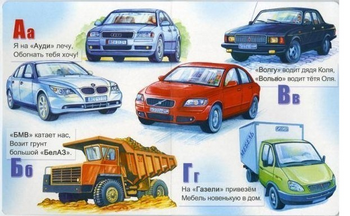
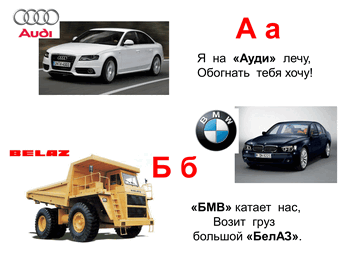

Leave a Reply